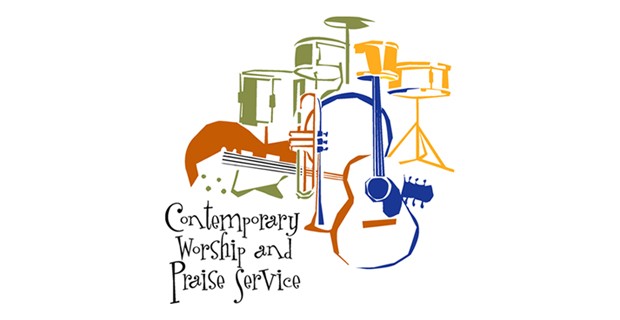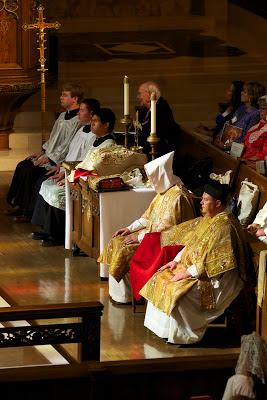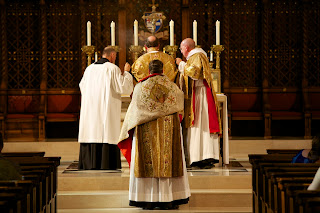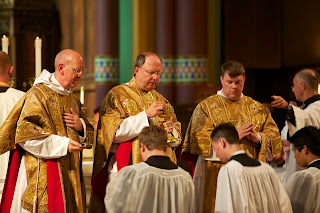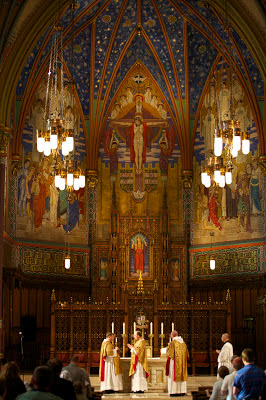Fr. Jan Larsen of Seattle offers the following thought on the Sign of Peace:
The greeting of peace is still a part of our liturgical prayer, really a kind of blessing that we exchange with those nearby, and this attitude of prayer and blessing ought not to take second place to other praiseworthy impulses. Thus care must be taken that the sign of peace does not become a sort of “time out” from the liturgy so that people can chat and socialize. That the sign of peace reflects a certain composure and restraint also applies to everyone else in the liturgical assembly. The church’s norms describe the sign of peace as the rite “by which the Church asks for peace and unity for herself and for the whole human family, and the faithful express to each other their ecclesial communion and mutual charity before communicating in the Sacrament…”
(h/t PrayTel)
I'm happy to see some discussion about this topic. In most parishes I've been to, things are not quite all terrible at the Sign of Peace. There is a period time that lasts perhaps 10 to 15 seconds, and Catholics mostly try to make the best of it, even if it is a bit uncomfortable. in general, it seems relatively harmless and perhaps it even makes some people feel a sense of charity toward each other -- a good thing but one that needs to be balance against what often seems like a disruption in the course of the prayer during the most solemn part of Mass.
Maybe your parish is different. I recall being in a college chapel in which the sign of the peace involved milling around for several minutes or longer, including loud talking, catching up on the events of the day, and so on. If someone feels a bit funny about this, that person is made to have an awkward sense that he or she is aloof or unsocial or unfriendly. I've read other reports about celebrants coming down from the altar and going into the congregation to shake everyone's hand. At some point, the Sign of Peace, because it is not clearly defined in rubrics, can look much like an abuse.
So it is good to understand the difference between what the rubrics say and what has emerged as popular tradition. Here is what the General Instruction says about the rite of peace:
82. There follows the Rite of Peace, by which the Church entreats peace and unity for herself and for the whole human family, and the faithful express to each other their ecclesial communion and mutual charity before communicating in the Sacrament.
As for the actual sign of peace to be given, the manner is to be established by the Conferences of Bishops in accordance with the culture and customs of the peoples. However, it is appropriate that each person, in a sober manner, offer the sign of peace only to those who are nearest.
So here we have it. There is no need for walking around and socializing, or even for waving across the parish to another person. If someone is not right nearby, there should be no pressure for anyone to seek out others. It should be quiet, contain, and short. It should not involving anything other than saying "peace be with you" or responding "amen." It is possible to do this with dignity.
The Roman Missal itself makes it clear that the ritual is fully accomplished when the priest says: "The peace of the Lord be with you always" and the people respond: "And with your spirit." There is no necessary need for anything else. In fact, the Missal says that the celebrant "may add, when appropriate: Let us offer each other the sign of peace."
In other words, the congregational peace exchange can be eliminated completely -- and I'm quite certain that may people will feel a sense of relief over this. I am among them.
At the same time, Brandon Harvey, a theology student at Stubenville, writes as follows:
Another option to eliminating it completely is to solemnize it by singing the rite itself. The sound alone makes it clear that this is not a break in the liturgy but a part of it, thereby inspiring a more liturgical approach from the people in the pews.
The Roman Missal itself makes it clear that the ritual is fully accomplished when the priest says: "The peace of the Lord be with you always" and the people respond: "And with your spirit." There is no necessary need for anything else. In fact, the Missal says that the celebrant "may add, when appropriate: Let us offer each other the sign of peace."
In other words, the congregational peace exchange can be eliminated completely -- and I'm quite certain that may people will feel a sense of relief over this. I am among them.
At the same time, Brandon Harvey, a theology student at Stubenville, writes as follows:
This distraction, felt by many, has led some priest to react by deeming it never “appropriate” to show the sign of peace. But one must reflect on the teaching of Benedict XVI, pope emeritus, “It should be kept in mind that nothing is lost when the sign of peace is marked by a sobriety which preserves the proper spirit of the celebration, as, for example, when it is restricted to one’s immediate neighbors.”Of course in the extraordinary form, matters are very different and solemn. There is no assigned time for the faithful to engage in what often seems like a "meet and greet." In fact, I've had protestant friends of mine come to Mass and be slightly disoriented during this period of the Mass since it reminds them of the horizontal and social elements of their own services, and not in a good way.
Another option to eliminating it completely is to solemnize it by singing the rite itself. The sound alone makes it clear that this is not a break in the liturgy but a part of it, thereby inspiring a more liturgical approach from the people in the pews.
I'm curious about other people's experiences. Does the sign of peace make enough of a contribution to the liturgy to justify the risks that it gives rise to disruption? In general, I would say no it does not.









